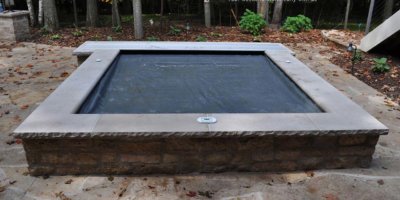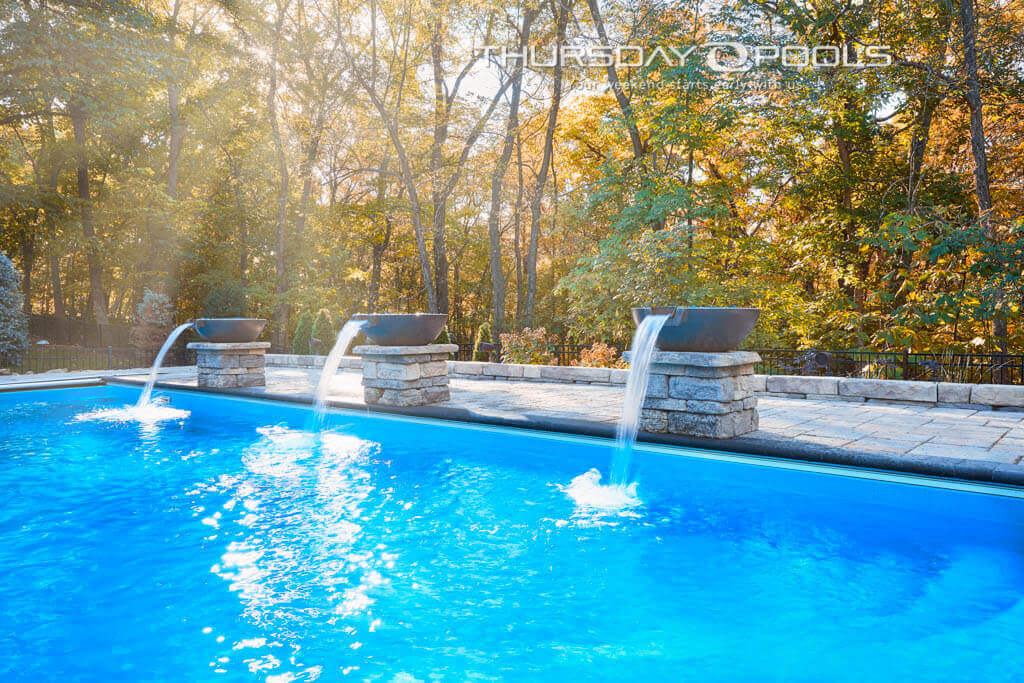877-929-(7665)
How to Close a Pool For Winter
HOW TO CLOSE A POOL FOR WINTER
 This too, shall pass. For those of us who live for the juxtaposition of the warm sun and luxurious cool pool water while living in a state with four seasons, waiting out the winter is a necessary evil. And making sure you are ready to enjoy your pool as soon as possible means closing your pool properly for the winter. If you live in a state with a freeze/thaw cycle, you may be wondering, “What does a pool closing include?” Some questions to consider when learning how to close a pool for winter may include:
This too, shall pass. For those of us who live for the juxtaposition of the warm sun and luxurious cool pool water while living in a state with four seasons, waiting out the winter is a necessary evil. And making sure you are ready to enjoy your pool as soon as possible means closing your pool properly for the winter. If you live in a state with a freeze/thaw cycle, you may be wondering, “What does a pool closing include?” Some questions to consider when learning how to close a pool for winter may include:
- How do you know when to close the pool for the winter (i.e. what month do you close a pool?
- Why is winter water level maintenance important?
- How far down do you drain your pool for winter? How low should pool water be in winter? How high should pool water be in winter? And can you winterize the pool without draining?
- What to put in the pool before closing? What chemicals do you need to close a pool for the winter? Do you need antifreeze to close the pool for winter? Should you shock the pool before closing?
- What are the steps for closing a pool? How do you winterize a pool step by step?
Let’s get to answering those questions!
How do you know when to close the pool for the winter?
What month you close a pool for the winter depends on where you live and whether you have a pool heater or not. Many homeowners keep their pools open from Memorial Day to Labor Day, but if you have a pool heater, you could swim from April to October. You don’t want to close your pool too soon either because closing too early will increase the risk of algae growth. Fiberglass pools are naturally algae resistant, but vinyl liner and gunite pools are more prone to algae growth. So whether you will be swimming in your pool or not, for the health of the water you will be swimming in next season, make sure the water temperature is consistently below 65 degrees before stopping your filtration system and closing your pool.
Why is winter water level maintenance important?
All inground pools have a common enemy. It’s called groundwater. Groundwater can wreak havoc on every type of pool if you allow its level to rise too close to the water level in your pool. In the winter months, while you’re busy watching football and baking Christmas cookies, you need to be sure that your water level underneath your winter cover doesn’t get out of whack with the groundwater around your pool, or you might be in for a world of hurt (and expense) when you pull that cover off in the spring. Here’s what might happen, based on the type of pool you have:
Vinyl Liner Pools: On a vinyl pool, if the water level inside the pool becomes lower than the water on the outside, the result is something we refer to as “floating the liner” which is not a good thing. It means that the liner is wrinkled and damaged beyond repair. A pool maintenance pro will have to drain the pool completely and replace the liner.
Fiberglass Pools: If the pressure of groundwater exceeds the pressure of the water inside your pool, your fiberglass pool shell might shift, crack, or float. Proper winterization and balancing inner vs outer water levels are the keys to protecting against these issues. Having additional add-ons to secure your fiberglass pool, like the Geo-Anchoring Pool System, can grant you additional support, as well.
Gunite Pools: Groundwater pressure can cause cracks in gunite pools over the winter as well, resulting in the need for resurfacing. Ceramic tile along the waterline can also be adversely affected. The worst possible issue is flooding. If groundwater is not managed properly, a gunite pool can actually float.
How far down do you drain your pool for winter?
Lowering your pool water can really cause some problems when Old Man Winter kicks it into high gear and Frosty the Snowman starts dancing across your pool cover. Every pool company has its own opinions and you’ll find conflicting information out there on the world wide web about the proper water level for winterization.
When water freezes, it expands. The pressure of that expansion can crack your skimmer. Many pool professionals choose a Gizzmo, designed to absorb the pressure from ice expansion to prevent it from destroying the skimmer. It can be used in both above and inground pools.
The Gizzmo has a plug on the top of it that is left open while air is blown from the pump area through the lines, clearing them of water. Most pool maintenance pros will then pour a gallon of antifreeze through the opening and into the piping to ensure the lines won’t freeze. Once the plug is screwed on tightly, water can’t get back into the piping.
We believe your best bet is to maintain your water level to just below the midway point of your skimmer. Doing so means you’re most likely to keep your water level in balance with groundwater throughout the freezing weather. One of the benefits of an automatic pool safety cover over a standard winter cover is the ease of being able to take a peek periodically at your water level.
What to put in the pool before closing
If you live in a part of the country where winter temperatures are freezing or below freezing, you’ll need non-toxic antifreeze to protect your plumbing. Just like the summer, you should make sure your pool chemistry is balanced before winterizing.
Chemicals for winterizing your pool:
-
- Shock. If your water chemistry is balanced before you close your pool there is no need to shock the pool at closing. During the winter months, your chlorine demand is much lower (if not zero) requiring little to no chlorine in your pool. Generally the residual chlorine in your pool left over from the standard season is enough to combat algae growth through the fall if you do not close the pool until after the average temperatures are below 65 degrees.
- Stain and scale treatment. If needed, add stain and scale treatment a day before closing. Adjusting the pool pH to 7.2-7.8 will prevent staining, scaling and algae growth, so you may need a pH increaser or reducer.
- Winter algaecide. Winter algaecide is generally put in the pool at the time of closing.
- Non-toxic antifreeze. This chemical is not actually put in the pool water. It’s used in the plumbing lines to prevent cracking and bursting.
What are the steps for closing a pool?
Whether you choose to do some (or all) of it yourself, or hire a pool professional to winterize your inground pool, there are certain steps you’ll want to take to ensure a happy opening in the spring.
Step 1: Clean your pool.
Remove all debris, brush the pool’s walls and vacuum.
Step 2: Balance water chemistry.
Test the water and adjust with the proper chemicals to reach the following levels:
- CHLORINE RESIDUAL – 1.0 TO 3.0 PPM
- PH LEVEL – 7.2 TO 7.6
- TOTAL ALKALINITY – 80 TO 120 PPM
- CALCIUM HARDNESS – 150 TO 200 PPM (Note: if you own a fiberglass pool, be sure to avoid using Calcium Hypochlorite.)
- CYANURIC ACID (CHLORINE STABILIZER) – 30 TO 50 PPM
- METALS – 0 PPM
- TDS – LESS THAN 1500 PPM (Note: if you have a salt system, maximum should be 1000 PPM above safe salt level)
- SALT – 2700 TO 3400 PPM (Note: this is only necessary if using a salt generator)
- LANGELIER SATURATION INDEX (-0.3 to +0.3). IDEAL IS 0. (Note: if you have a salt system, your saturation index should be between -0.2 and 0.2 to account for the additional corrosive characteristics of salt)
Step 3: Remove and store equipment/accessories.
Remove solar blankets and ladders from the pool, and store in a clean, dry area for winter. You’ll also want to remove and store skimmer baskets, wall fittings, floating lights, etc.
Step 4: Achieve proper water level.
Using the filter pump or a submersible pump, you may need to lower the water level. Check your pool manufacturer’s manual or consult your pool dealer.
Step 5: Drain water from equipment.
Drain water from your pump, filter, heater and chlorinator by removing the drain plugs. All water must be drained or blown out of your equipment so it doesn’t freeze, expand, and crack the equipment. If you have an inground pool, blow out the lines starting at the skimmer and then plug the lines at the pool using expansion plugs. As an additional safety measure, you may also use non-toxic antifreeze in the lines following manufacturer’s instructions.
Step 6: Cover the pool.
A winter safety cover that fits tightly is needed. You may have a mesh safety cover or solid (non-perforated) cover. Mesh will allow water to seep into the pool, and a non-perforated cover will require you to use a cover pump to remove rain water and snow melt.
Knowing how to close a pool for winter doesn’t mean you need to do it yourself. It’s good to know what goes into closing a pool for winter so you can be sure that it’s being done correctly. Always follow manufacturer’s instructions as not doing so may result in problems and a voided warranty.
